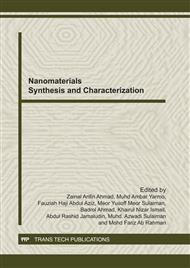p.25
p.30
p.35
p.40
p.45
p.50
p.55
p.60
p.65
Characterization of Urea versus HMTA in the Preparation of Zinc Oxide Nanostructures by Solution-Immersion Method Grown on Gold-Seeded Silicon Substrate
Abstract:
Zinc oxide (ZnO) nanostructures prepared by immersion method were successfully grown on gold-seeded silicon substrate using Zinc nitrate hexahydrate (Zn (NO3)2.6H2O) as a precursor, separately stabilized with non-toxic urea (CH4N2O) and hexamethylene tetraamine (HMTA). The effect of changing the stabilizer of ZnO solution on the crystal structure, morphology and photoluminescence properties of the resultant ZnO is investigated. X-ray diffraction of the synthesized ZnO shows hexagonal zincite structure. The morphology of the ZnO was characterized using Field Emission Scanning Electron Microscope (FESEM). The growth of ZnO using urea as stabilizer shows clusters of ZnO nanoflower with serrated broad petals were interestingly formed. ZnO in HMTA showed growth of nanorods. The structures has high surface area, is a potential metal oxide nanostructures to be develop for optoelectronic devices and chemical sensors. The formation of ZnO nanostructures is found to be significantly affected by the stabilizer.
Info:
Periodical:
Pages:
45-49
Citation:
Online since:
October 2011
Price:
Сopyright:
© 2012 Trans Tech Publications Ltd. All Rights Reserved
Share:
Citation:


